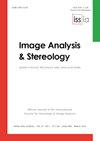COMPARISON OF ULTRASOUND IMAGE FILTERING METHODS BY MEANS OF MULTIVARIABLE KURTOSIS
IF 1
4区 计算机科学
Q4 IMAGING SCIENCE & PHOTOGRAPHIC TECHNOLOGY
引用次数: 7
Abstract
Comparison of the quality of despeckled US medical images is complicated because there is no image of a human body that would be free of speckles and could serve as a reference. A number of various image metrics are currently used for comparison of filtering methods; however, they do not satisfactorily represent the visual quality of images and medical expert’s satisfaction with images. This paper proposes an innovative use of relative multivariate kurtosis for the evaluation of the most important edges in an image. Multivariate kurtosis allows one to introduce an order among the filtered images and can be used as one of the metrics for image quality evaluation. At present there is no method which would jointly consider individual metrics. Furthermore, these metrics are typically defined by comparing the noisy original and filtered images, which is incorrect since the noisy original cannot serve as a golden standard. In contrast to this, the proposed kurtosis is the absolute measure, which is calculated independently of any reference image and it agrees with the medical expert’s satisfaction to a large extent. The paper presents a numerical procedure for calculating kurtosis and describes results of such calculations for a computer-generated noisy image, images of a general purpose phantom and a cyst phantom, as well as real-life images of thyroid and carotid artery obtained with SonixTouch ultrasound machine. 16 different methods of image despeckling are compared via kurtosis. The paper shows that visually more satisfactory despeckling results are associated with higher kurtosis, and to a certain degree kurtosis can be used as a single metric for evaluation of image quality.超声图像多变量峰度滤波方法的比较
比较无斑点的美国医学图像的质量是复杂的,因为没有没有斑点的人体图像可以作为参考。许多不同的图像度量目前用于过滤方法的比较;然而,它们不能令人满意地代表图像的视觉质量和医学专家对图像的满意度。本文提出了一种创新的使用相对多元峰度来评估图像中最重要的边缘。多变量峰度允许人们在过滤后的图像中引入一个顺序,并且可以用作图像质量评估的指标之一。目前还没有一种方法可以联合考虑各个指标。此外,这些指标通常是通过比较有噪声的原始图像和过滤后的图像来定义的,这是不正确的,因为有噪声的原始图像不能作为黄金标准。与此相反,提出的峰度是绝对度量,它是独立于任何参考图像计算的,在很大程度上符合医学专家的满意度。本文给出了一个计算峰度的数值过程,并描述了计算机生成的噪声图像、通用幻像和囊肿幻像的计算结果,以及用SonixTouch超声机获得的甲状腺和颈动脉的真实图像。通过峰度分析比较了16种不同的图像去斑方法。本文表明,视觉上满意的去斑结果与较高的峰度相关,峰度在一定程度上可以作为评价图像质量的单一指标。
本文章由计算机程序翻译,如有差异,请以英文原文为准。
求助全文
约1分钟内获得全文
求助全文
来源期刊

Image Analysis & Stereology
MATERIALS SCIENCE, MULTIDISCIPLINARY-MATHEMATICS, APPLIED
CiteScore
2.00
自引率
0.00%
发文量
7
审稿时长
>12 weeks
期刊介绍:
Image Analysis and Stereology is the official journal of the International Society for Stereology & Image Analysis. It promotes the exchange of scientific, technical, organizational and other information on the quantitative analysis of data having a geometrical structure, including stereology, differential geometry, image analysis, image processing, mathematical morphology, stochastic geometry, statistics, pattern recognition, and related topics. The fields of application are not restricted and range from biomedicine, materials sciences and physics to geology and geography.
 求助内容:
求助内容: 应助结果提醒方式:
应助结果提醒方式:


